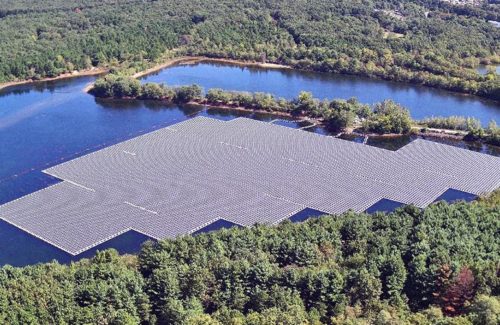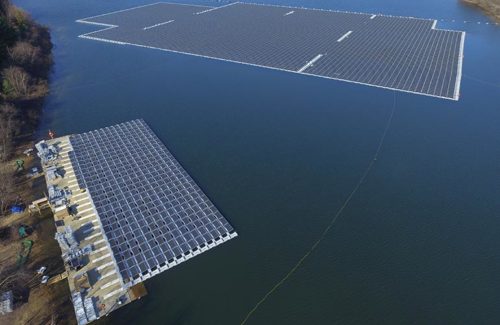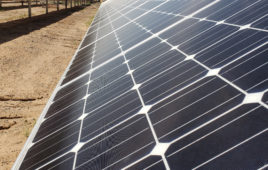Installing a floating solar system in the United States is still a novel effort. The first “floatovoltaic” array in the world was installed a decade ago at a California winery, but solar systems that reside atop stagnant water still haven’t claimed a significant share of the U.S. solar market.
NREL released a study in 2018 that claimed if solar was installed on just a quarter of the manmade bodies of water in the United States, it would account for 10% of the country’s electricity needs.

RETTEW, Solar Renewable Energy and J&J Solar completed a 4.4-MW floating solar system in Sayreville, New Jersey, the first in the state and the largest in the country.
Engineering firm RETTEW and contractors Solar Renewable Energy (SRE) and J&J Solar pushed U.S. floating solar into new waters with the construction of a 4.4-MW array on a retention pond in Sayreville, New Jersey. It’s currently the only floating solar array in the state, and the largest in the country. It powers 100% of Sayreville’s water treatment plant.
“We’re using ‘land’ that doesn’t have any other value associated with it,” said Jason Wert, senior program manager of Energy & Environmental Engineering at RETTEW. “We’re not taking farmland and making it into solar. We’re not cutting down a forest to make it into solar. We’re using a resource that continues to be a resource and we’re putting a second use on it.”
Making it float
The Sayreville floating solar system was a first for everyone involved. A lack of domestic floating solar meant RETTEW, SRE, J&J and their subcontractors had to look for guidance internationally or use personal intuition to figure out how to best assemble and align the array.
“I mean, row-by-row, this is 12,700 panels that went to the water, so it’s pretty intensive from the hands-on, piece-by-piece activity,” said Steve Crimmel, sales director at SRE. “We invested in training upfront for our install supplier. We made that investment to be well-prepared, ahead of the game here and practiced what was needed.”
That meant buying floats and practicing putting them together before installing anything in the water. During construction, subcontractors assembled floats on a 200-ft dock, wiring the panels and pushing each completed row into the water. Most rows were 27-floats long and were launched into the water with a flexible angling ramp, then they were pulled by boat into the center of the retention pond and added to the array.

Subcontractors assembled 12,700 floats to hold just as many solar panels on a 200-ft dock. After panel rows were assembled, they would pull them out into the center of the retention pond by boat.
“The newness of it too meant that we were kind of blazing the trail here through the woods,” Crimmel said. “There was nowhere to go to look to see how best to anchor, how best to assemble, what to do. But it’s funny, as you look around the world…people in different continents can figure out similar ways of accomplishing the same thing with a little engineering ingenuity.”
The system was built modularly with separate combiner boxes for each section. To match the shape of the retention pond, the array has a sawtooth design that still maintains a distance from the shore. The array is made of HT-SAAE 345-W panels, Ciel & Terre Hydrelio floats and ABB inverters.
Permitting on the project began in 2016 and took two-and-a-half years, followed by another six months of construction. During that period, installers worked in temperatures above 100°F and below freezing. They had to learn to work on a surface that would rise and fall 12 ft with condensation, draining and evaporation, and had to design a system that would account for that fluctuation — as well as hurricane-force winds.
The area permitting authority required on-water construction projects be secured to a body of water’s shore instead of its bed. It’s standard procedure to anchor floating solar arrays to a waterbed, Wert said. This took longer design considerations from RETTEW to ensure this non-traditional anchoring could handle New Jersey’s weather demands.

Sayreville’s floating solar system powers the town’s water treatment plant. The array resides in a public park, and although anchored to the shore, still left enough space for fishing.
“If you go around the world, the majority of these systems are anchored to the bottom of the reservoir,” Wert said. “It’s efficient, it’s reliable and it’s a modest cost — probably your most cost-effective. New Jersey and other states that we are working with don’t necessarily view it the same way. They prevented us from anchoring to the bottom of the reservoir, so the normal techniques you would use weren’t available to us and we had to design something very custom to do the Sayreville job.
“The anchoring is really the heart of the design, and these wind loads and how you design for that and the regulations, that all creates a risk situation that has to be managed,” he continued. “That, I will tell you, is the heart of what we spent a lot of our time on.”
A symbiotic relationship
Now that the solar project is complete, Sayreville’s three water treatment retention ponds continue to operate normally. The nearby Raritan River diverts water into the reservoirs near the treatment plant, which can process 7 million gallons of water per day, with a total holding capacity of 14 million gallons. The landscape surrounding the three retention ponds is a wooded public park with walking paths and fishing access.
“I had a couple fisherman very concerned about [the array], and I said, ‘Hey, less algae, plenty of water and lots of shade — the bass are going to get really big now,’” Crimmel said.
Floating solar systems can reduce algae counts and evaporation through shading. In turn, mounting solar systems on water can lower module temperatures and increase power production. While installing solar projects on water brings unique challenges, floating arrays have the advantages of greater panel density and a smaller install footprint than ground-mounted arrays.
Wert said the Sayreville system is outperforming its projected output past solar noon. While it isn’t entirely clear what the cause is, he expects that the panels are catching light reflected off the water from the setting sun.
While he couldn’t disclose specific details, Wert said RETTEW is in the preliminary stages of developing more, even larger floating solar projects.
“I think [floating solar’s] going to grow pretty rapidly,” he said. “I don’t foresee that it’s going to overtake the residential space or the utility-scale, [but] it’s going to have a role in the market and it’s going to make sense.”





Tell Us What You Think!